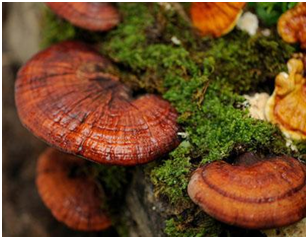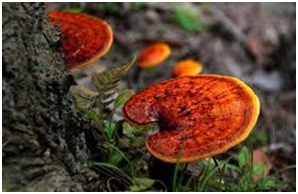Reishi
Mushroom
Reishi Mushroom, also known as Ganoderma or
Lingzhi, is a polypore mushroom that grows on wood in dark and moist
environment. It usually consist of a rounded and soft mushroom cap and a long
stem. The Ganoderma genus includes about 80 species. Among them, Ganoderma
Lucidum, or red Reishi, is the most studied and used species.
Ganoderma and its extensive use has been
documented in many traditional Chinese medical literature for more than a
thousand years due to the health benefits it has. In ancient China, because
wild Ganoderma was very difficult to find, it was only served to the emperors. Therefore,
it was also called [The Magic Herb". Nowadays, thanks to the development of
modern cultivation and processing techniques, Ganoderma has become more available
and more affordable to people. Many scientific researches have also been done
on the potential health benefits of Reishi Mushroom.
Studies have shown that Reishi Mushroom has
multiple health benefits. It is effective in enhancing overall immunity,
protecting the liver, and improving sleep quality. The main two active
compounds are called Ganoderma polysaccharides and triterpenes. Ganoderma
polysaccharides can activate human`s immune system, increasing the activity and
number of immune cells. Triterpenes, on the other hand, can fight directly
against pathogens and abnormal cells such as tumor cells. Therefore, Reishi
Mushrooms is also good for assisting cancer treatment.
Most people may think that wild Reishi
Mushrooms are better than cultivated ones while in fact that is not the case. Since
Reishi Mushrooms are a type of fungi, they acquire their food by absorbing
dissolved molecules. Therefore, they are very likely to absorb pollutants into
their tissues, including heavy metals such as mercury. That is also why many
countries use mushrooms to clean up waterways and soil. However, since it is impossible
to control and screen the source of every mushroom we collect, wild Reishi
Mushrooms are very likely to have contaminants inside. Also, Reishi Mushrooms
use their spores to spread and reproduce. As it reaches maturation phase, the
spores will shoot out from tiny tubes underneath the cap. The spore powder is
also where most of the nutrients of Reishi Mushroom are stored. In the wild, we
cannot keep monitoring every growth stage of Reishi Mushroom, so most of the
time the Reishi Mushrooms we collect do not have much spores left, which means
they have much less nutritious value. Besides, there are other factors that may
affect the quality of Reishi Mushrooms such as sunlight, humidity, parasites
etc. GANOHERB on the other hand, has been focusing on growing Reishi Mushroom
for 29 years. It has multiple self-built Ganoderma farms and therefore is able
to control and monitor every step that may affect the quality of Reishi
Mushroom, delivering the Reishi Mushroom with highest quality and safety. We
strictly controls every single step of the cultivation process to ensure each
step is ideal for the growth of Reishi Mushroom. GanoHerb has acquired 4
organic certifications from the EU, the US, Japan, and China. Our goal is to
let the world share the traditional Chinese treasure.
Reishi Mushroom Reishi Mushroom,Raw Reishi Mushroom,Organic Reishi Mushroom,Reishi Mushroom Powder Ganoherb International Inc , http://www.ganoherb.com


Cotton non-pruning cultivation techniques
Cotton's simplification of cultivation and management techniques, especially the pruning-free technique, is a technological transformation of cotton from traditional cultivation management to modern cultivation and management, and is also an inevitable trend for the development of cotton cultivation. After many years of experiments and demonstrations, the Hexin City Guoxin Agricultural Research Institute has explored a set of successful experiences. In 1999, the area of ​​6,000 mu of cultivated cotton fields was used to produce 90 kg of lint, and more than 2,000 mu of mu produced reached more than 100 kg. According to the 1999 pruning and non-pruning survey, 3176 mu were left with 13.6 bolls per plant, 93 kg per mu for lint, 21.7 for no-pruning, and 111 kg for lint per mu. The main reasons for the increase in production without pruning are: strong roots, leafy leaves, increased photosynthetic capacity, and relatively increased buds; second, self-adjusted ability to prevent premature aging; third, less axillary buds, slow growth, and reduced nutrient consumption. The main supporting cultivation techniques are as follows: (1) Fertilizer fertility due to pruning and cultivation of cotton plants, large bells, and high yields are suitable for planting in soils with good water and fertilizer conditions. Guoxin Agricultural Research Institute cotton field, after returning straw for consecutive years, the soil organic matter reached more than 0.15%. The poor fertility cotton field is based on the application of organic fertilizer, and the application of N, P, K ternary compound fertilizer (each containing 15%) 30-35kg, followed by 15-20kg. (ii) Selection of suitable varieties and appropriate sparsely planted cotton to avoid pruning should be suitable for medium-early-maturing and strong-bellied insect-resistant cotton varieties. Guoxin Agricultural Research Association breeds Guokang 97-1 and other varieties. The axillary buds have the characteristics of easy formation of sub-fruits and sub-fruiting branches. Therefore, the pruning cultivation has achieved a good harvest year after year. The density of seedlings is appropriate to about 3,000 strains. It should be properly sparse during the rainy year, and should be more dense during the rainy year. (3) Controlling the number of leaf shoots The cotton seedlings usually have 1–5 leaf shoots below the fruiting branch. The yield of each leaf was 1–3 leaf shoots per experiment. Therefore, the number of leaf shoots should be controlled appropriately. Usually only key water is used to control the seedling stage. The method of water and fertilizer can achieve this purpose, and manual control can also be adopted. (D) early topping, do a good job of chemical control cotton pruning plant growth and development faster, topping time than regular pruning 3 - 5 days earlier, on July 15 is appropriate, the latest not later than July 20th. In order to promote the balanced growth of its leaves and main branches, the general year of chemical control should start from the initial flowering stage, with the use of dildo-amine l--3g and flowering-ring period for 3-5 days. Hejian City Agricultural Bureau Zhang Decai Zhang Hongying